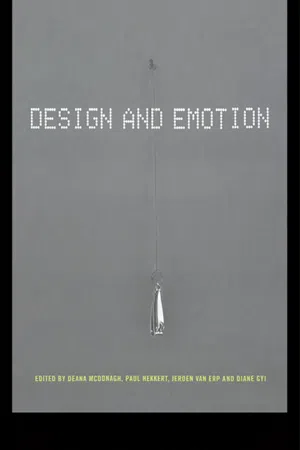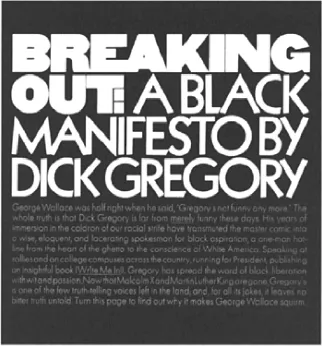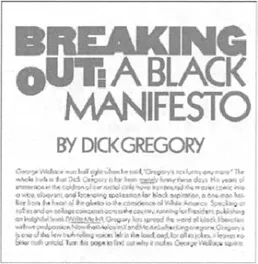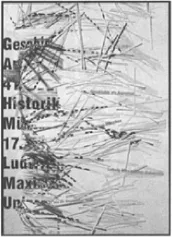
eBook - ePub
Design and Emotion
Deana McDonagh,Paul Hekkert,Jeroen van Erp,Diane Gyi
This is a test
- 456 pagine
- English
- ePUB (disponibile sull'app)
- Disponibile su iOS e Android
eBook - ePub
Design and Emotion
Deana McDonagh,Paul Hekkert,Jeroen van Erp,Diane Gyi
Dettagli del libro
Anteprima del libro
Indice dei contenuti
Citazioni
Informazioni sul libro
There is considerable interest in and growing recognition of the emotional domain in product development. The relationship between the user and the product is paramount in industry, which has led to major research investments in this area. Traditional ergonomic approaches to design have concentrated on the user's physical and cognitive abil
Domande frequenti
Come faccio ad annullare l'abbonamento?
È semplicissimo: basta accedere alla sezione Account nelle Impostazioni e cliccare su "Annulla abbonamento". Dopo la cancellazione, l'abbonamento rimarrà attivo per il periodo rimanente già pagato. Per maggiori informazioni, clicca qui
È possibile scaricare libri? Se sì, come?
Al momento è possibile scaricare tramite l'app tutti i nostri libri ePub mobile-friendly. Anche la maggior parte dei nostri PDF è scaricabile e stiamo lavorando per rendere disponibile quanto prima il download di tutti gli altri file. Per maggiori informazioni, clicca qui
Che differenza c'è tra i piani?
Entrambi i piani ti danno accesso illimitato alla libreria e a tutte le funzionalità di Perlego. Le uniche differenze sono il prezzo e il periodo di abbonamento: con il piano annuale risparmierai circa il 30% rispetto a 12 rate con quello mensile.
Cos'è Perlego?
Perlego è un servizio di abbonamento a testi accademici, che ti permette di accedere a un'intera libreria online a un prezzo inferiore rispetto a quello che pagheresti per acquistare un singolo libro al mese. Con oltre 1 milione di testi suddivisi in più di 1.000 categorie, troverai sicuramente ciò che fa per te! Per maggiori informazioni, clicca qui.
Perlego supporta la sintesi vocale?
Cerca l'icona Sintesi vocale nel prossimo libro che leggerai per verificare se è possibile riprodurre l'audio. Questo strumento permette di leggere il testo a voce alta, evidenziandolo man mano che la lettura procede. Puoi aumentare o diminuire la velocità della sintesi vocale, oppure sospendere la riproduzione. Per maggiori informazioni, clicca qui.
Design and Emotion è disponibile online in formato PDF/ePub?
Sì, puoi accedere a Design and Emotion di Deana McDonagh,Paul Hekkert,Jeroen van Erp,Diane Gyi in formato PDF e/o ePub, così come ad altri libri molto apprezzati nelle sezioni relative a Business e Project Management. Scopri oltre 1 milione di libri disponibili nel nostro catalogo.
Informazioni
EMOTIVE EFFECTS OF VISUAL PROPERTIES
Using “visual/verbal interplay” to tap into collective memory and shared understanding
Susan M Hagan
Carnegie Mellon University, USA
Carnegie Mellon University, USA
INTRODUCTION
Communication design still searches for a theory of invention and composition that includes not only “looking” interests but also visual/verbal interaction. My work indicates that interaction revolves around one of three kinds of look/read meaning integration. I c all the f irst “parallel p lay,” the s econd “sequenced p lay,” and the third, “visual/verbal interplay.”
Parallel play, sequenced play and interplay all serve important communication functions. In each, visual and verbal “modality selections” can tap into collective memory and shared visual understanding. However, visual/verbal interplay has the potential to create collaborations so tightly semantically and structurally linked that concept meaning would be significantly altered if the words and visuals were isolated.
PARALLEL PLAY
Parallel play connects visual to verbal information primarily by way of visual juxtapositions such as the example created by Josef Muller-Brockmann (1981; see Figure 1).

Figure 1 Parallel Play
(Grid System, Josef Mueller-Brockmann, ISBN 3721201450, Verlag Niggli AG, Switzerland)
Muller-Brockmann’s work typifies elegant parallel play. We perceive the visual and verbal collaboration primarily because the two elements are close together. Visual proximity encourages groupings (Arnheim, 1974). Even though the words are too small to read, this layout still holds together. In terms of the collaboration between word and image, the text is important for its placement on the page rather than its content. The composition does not depend heavily on meaning relationships between the text and the visual nor does it rely on particular images to hold the work together. Of course connections between the two exist, but parallel play invites audiences to create loose connections between visual and verbal information in their own time and at their own pace. Muller-Brockmann’s grid is one way to create these loose connections. Although it will be the only approach discussed in this paper, it is not the only method.
VISUAL/VERBAL INTERPLAY
Like parallel play visual/verbal interplay also depends on placement to hold the two modalities together. But interplay must modify as well as add to the composing practices used in parallel play in order to create compelling visual/verbal collaborations that enhance an audience’s experience. In order to see how visual/verbal interplay creates an experience that differs from the parallel play shown earlier, two examples of interplay will be presented. First you will see the word separated from the visual. Then you will be able to view the visual/verbal composition. In both cases, the experience is never quite the same when the visual is separated from the verbal. In both cases, visual meaning links to the text not just because the two share the same space, but also because they are co-dependant contributors to the meaning of the message.
Example 1 The text below is separated from the visual. The example of Visual/Verbal Interplay can be seen in Figure 2.
Breaking Out: A Black Manifesto, by Dick Gregory George Wallace was half right when he said, “Gregory’s not funny any more.” The whole truth is that Dick Gregory is far from merely funny these days. His years of immersion in the caldron of our racial strife have transmuted the master comic into a wise eloquent and lacerating spokesman for black aspiration, a one-man hotline from the heart of the ghetto to the conscience of White America. Speaking at rallies and on college campuses across the country, running for President, publishing an insightful book (Write Me In!), Gregory has spread the word of black liberation with wit and passion. Now that Malcolm X and Martin Luther King are gone, Gregory’s is one of the few truth-telling voices left in the land; and for all its jokes, it leaves no bitter truth untold. Turn this page to find out why it makes George Wallace squirm. What compositional considerations give the visualisation of this text new meaning possibilities that imply no “breaking out” could happen? This work relies on subconscious cognitive interests (Solso, 1994) that can only take on directed meaning when under the influence of the text. In this example, text is crucial. Without it the visual emotional cue could not convey a directed experience because visual meaning is, for the most part, privately selected and interpreted (Solso, 1994). However, some visual attributes do seem to communicate across audiences. In this particular case, the work relies on our tendency to be depressed by dark colours (Solso, 1994). Lubalin weaves these cognitive tendencies with explicit word meaning in order to create co-dependant meaning interaction between the words and the visuals.

Figure 2 Interplay (Courtesy of The Herb Lubalin Study Center of Design and Typography, The Cooper Union School of Art, New York)
This work not only relies on the depressing effect of dark colours, it also employs a “spatial story” (Turner, 1996) that simulates physical constraint. A spatial story explains an abstract concept by translating it into an action we can more easily understand.
“Shame forced him to confess” is easy to understand even though shame has no physical presence. In the same way, the words “breaking out” have no actual physical presence, but their constraint in a tight space makes it appear that no breaking out can occur. The affect is ironic. Note how that affect changes when the dark colours and typographic constraints are removed in the example Figure 3.

Figure 3 Visual constraints removed
In “Breaking Out,” the arrangement of visual and verbal information creates an effect that communicates with visual immediacy and verbal direction. It would not be possible to do this using either modality alone.
The second example by Uwe Loesh communicates interplay differently.
Example 2 The text below is separated from the visual. The example of Visual/Verbal Interplay can be seen on the following page (Figure 4).
History as Argument Ludwig-Maximillans University September 17 to 20th, 1996
In his book, The Image and The Eye, Gombrich (1982) uses the divisions of language conceived by Karl Buhler to explain the workings of images. Buhler categorises l anguage functions as expression, description and arousal. Gombrich believes visual information functions best at the level of arousal of emotion. Images in isolation cannot describe or express the abstractions needed to make specific statements concerning what has been happening or what could happen. On the next page you can see how a combination of visual and verbal information begins to tap into the best of both worlds with clarity and immediacy.
History as Argument, taps into our collective memory (Radley, 1990), by combining the meaning possibilities in the visual information with explicit word meaning. Words constrain the meaning of visual cues (Hoffman, 1998). In combination with text, images encourage fewer, but sometimes more powerful, interpretations. History as Argument constrains the situated meaning of the utilitarian shredder from a neutral object that can protect privacy to one with a more sinister “enduring quality” (Radley, 1990).

Figore 4 Visual/verbal Interplay (Courtesy of Professor Uwe Loesch)
CONCLUSION
Parallel play is often the best available means of visual/verbal collaboration. That method allows the audience to create loose connections at their own time and pace. But at times we must create the invitation to read and look with an eye and ear toward visual/verbal interplay rather than parallel play. The tools we need to create these tight collaborations must include the compositional interests used to build parallel play. But in visual/verbal interplay, we must also communicate a single concept by destabilising the dominance of the text or the visual when a concurrent interest in both modalities can communicate emotion as well as description with more immediacy and power. Many writers and designers do not yet know how to fully connect and interweave one modality to another. But soon we will.
REFERENCES
Arnheim, R., 1974, Art and visual perception: A psychology of the creative eye , (CA:
University of California Press).
Gombrich, E.H., 1982, The image and the eye: Further studies in the psychology of pictorial representation , (New York: Cornell University Press).
Hoffman, D, 1998, Visual intelligence , (New York: Norton and Company).
Muller-Brockmann, J, 1981, Grid systems in graphic design: A visual communication manual for graphic designers, typographers, and three dimensional designers , (New York: Hastings House Publishers).
Radley, A, 1990, Artefacts, memory and a sense of the past, In Collective remembering , e dited by y M iddleton a nd E dwards, (United K ingdom: S age), p p. 46–59.
Solso, R.L., 1994, Cognition and the visual arts , (Cambridge: MIT Press).
Turner, M., 1996, The literary mind , (New York: Oxford University Press).
Lyrical visual
Frank Holmes
University of Gloucestershire, UK
University of Gloucestershire, UK
A VISUAL EXPOSITION OF THE SUNG WORD
Think back to when you were a child, a teenager. Do you remember the days of sitting in your room, in the darkness, listening to your favourite records? Do you remember playing them over and over again? As you listen to the music, you begin to dream. You become part of a scene. The words of the song are sometimes those you say. The music becomes the backdrop—a vivid adventure.
I have always been intrigued by the power of music and particularly of song, to create a form of visual expression. The tone and emotion of the singers voice, plus the combination of musical instruments, melody, rhythm and production mix, all add to develop a sense of colour and form. A song can take you to a particular place and time. You can feel and see something.
Nowadays, with the introduction of MTV, Q, Kerrang and other digital video music channels, we are presented with an instant vision of song, someone else’s visual interpretation. The pop-promo video has coloured our own unique way of seeing things. We are now more inclined to see things as others do. Perhaps we may identify with the words of international songwriter and record producer, Trevor Horn and his song, Video killed the Radio star (1979). In this recording he suggests that image has become more important than the music it represents.
Many recording artists have expressed doubt about the use of visual representation for the promotion of musical work. In Clinton Heylin’s biography of Bob Dylan, Behind the Shades (2000), Dylan talks of his concern about the video which will accompany his song, Neighbourhood Bully. “We wanted to do Neighbourhood Bully, but it’s difficult trying to explain to someone what you see. I haven’t really found anybody that really thinks a certain way”.
Lyrical Visual previewed in London’s, Dryden Street Gallery, Covent Garden, in April 1999. The exhibition was an attempt to combine my work as a songwriter, musician and artist, through the use of abstract illustration music and lyricism. Starting w ith a collection of ten original songs, it aimed to portray the various aspects of human emotion, from jealousy and hate to love and happiness.
The interrelationship of art and music is something many musician/artists have explored. Brian Eno, during his long career as musician, composer and producer, acknowledges the use of metaphor and image in the construction of new musical work. From Eric Tamm’s book, Brian Eno (1989). Eno explains how he sees certain synthesised sounds as “synthetic formica”, and other acoustic instrumental sounds as, “more like a forest, beautiful and complex at any degree of magnification.” Other musicians such as David Bowie and Paul McCartney have successfully combined their creative work in music and art. In a book about his paintings, Paul McCartney (2000) McCartney writes about the connection of his visual and musical work, “There is a big crossover between the two things, one the visual and one the sound. Space is very good. Negative space, (in music and art) is very important.
Lyrical Visual, is an exhibition of abstract graphic art. It is somewhat personal; my own visual interpretation of my own songs. Ever since the age of fourteen, (at the time my scribbled poems developed tunes) I have seen colours and shapes emerging in each new song composition. Lyrical Visual is an attempt to connect the aural with the visual. I have tried to paint the shapes that form f...
Indice dei contenuti
- COVER PAGE
- TITLE PAGE
- COPYRIGHT PAGE
- PREFACE
- KEYNOTE STORIES
- EXPERIENCE DRIVEN DESIGN
- GENERATIVE TOOLS
- EVALUATIVE TOOLS
- EMOTIVE EFFECTS OF VISUAL PROPERTIES
- EMOTIVE EFFECTS OF THE OTHER SENSES
- FROM DESIGN TO EMOTION
- AFFECTIVE USABILITY
- ATTACHMENT
- PRODUCT CHARACTER
- DESIGN AND EMOTION: THEORETICAL AND ETHICAL ISSUES
- EMOTION IN DESIGN
- DESIGN AND EMOTION WORKSHOPS
Stili delle citazioni per Design and Emotion
APA 6 Citation
McDonagh, D., Hekkert, P., Erp, J. van, & Gyi, D. (2003). Design and Emotion (1st ed.). CRC Press. Retrieved from https://www.perlego.com/book/1711981/design-and-emotion-pdf (Original work published 2003)
Chicago Citation
McDonagh, Deana, Paul Hekkert, Jeroen van Erp, and Diane Gyi. (2003) 2003. Design and Emotion. 1st ed. CRC Press. https://www.perlego.com/book/1711981/design-and-emotion-pdf.
Harvard Citation
McDonagh, D. et al. (2003) Design and Emotion. 1st edn. CRC Press. Available at: https://www.perlego.com/book/1711981/design-and-emotion-pdf (Accessed: 14 October 2022).
MLA 7 Citation
McDonagh, Deana et al. Design and Emotion. 1st ed. CRC Press, 2003. Web. 14 Oct. 2022.